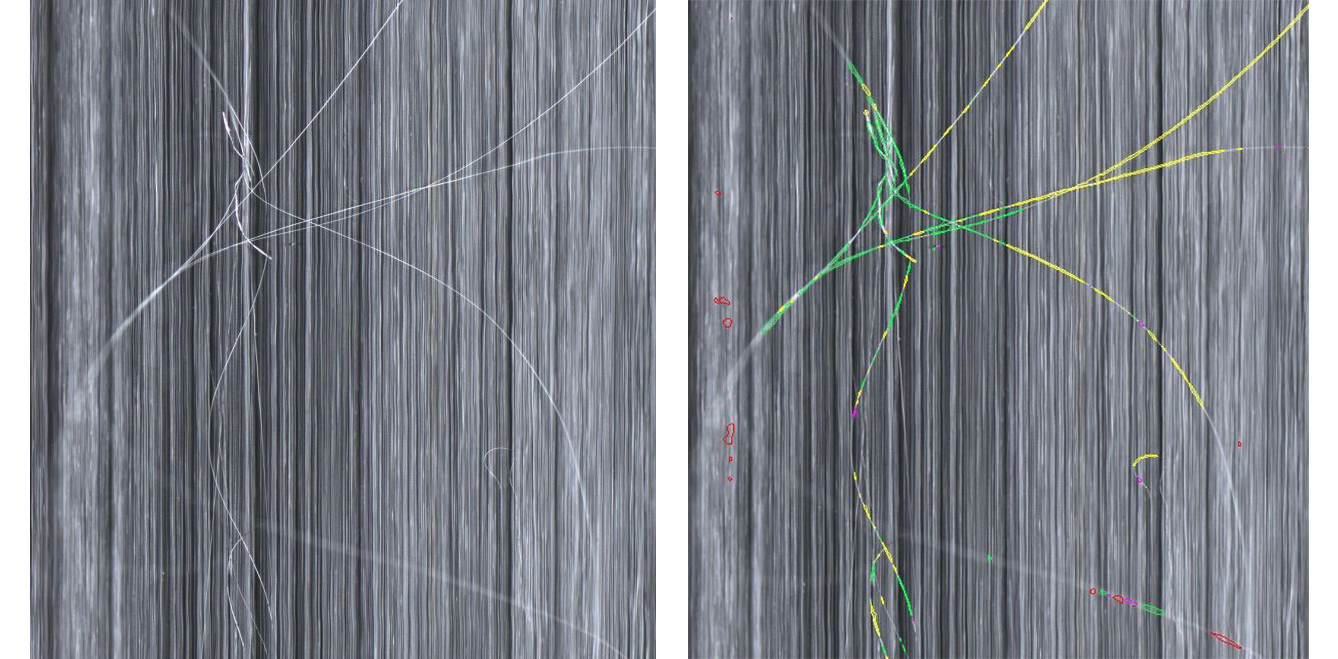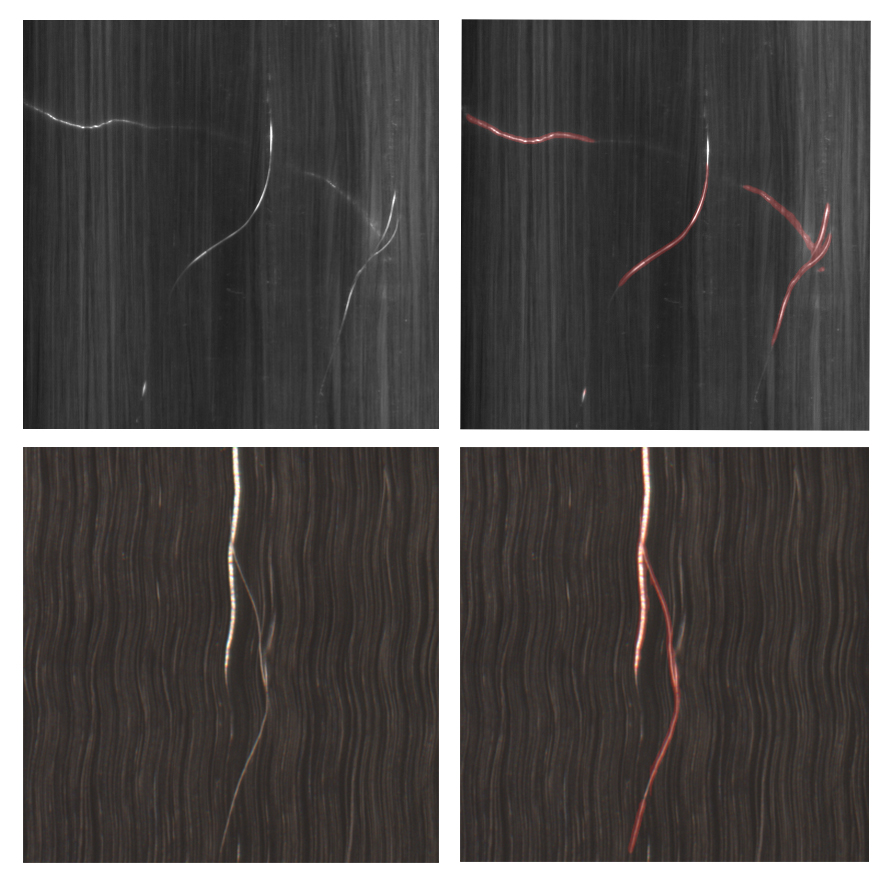AI in fiber technology: analyzing textures with line scan cameras
The online testing of fibers is not an easy task for measurement technology providers. Now Fraunhofer researchers have found a solution: Together with industrial partners, the staff of the Fraunhofer IGCV has succeeded in reliably detecting fiber defects in production. To do so, they use high-resolution camera systems and optimized neural networks.
Flight taxis, helicopters, passenger planes: the possible applications of carbon fibers in aviation are manifold. Lightweight construction has always been an issue here - and will remain so, not least because of climate change. However, the increasing use of carbon fibers also poses challenges for the industry:
- Production of fiber with high specific properties, such as stiffness strength,
- Good workability for different manufacturing processes, starting with braiding directly from the roving spool, through resin-impregnated towpregs for winding and automated laying processes, to woven fabrics and scrims draped manually or by robots and
- To meet the high safety requirements of the aviation industry.
The search for solutions is going on. Since 2011, SGL Carbon has been developing a European high-performance carbon fiber suitable for aviation. It is being developed at the pilot plant that the Company operates at its site in Meitingen. The plant is a core component of the »AirCarbon« project funded by the Federal Ministry of Economics and Energy (BMWi), in which industrial partners under the leadership of the SGL Group are developing high-strength carbon fibers for use in aviation for the first time in Europe. Onboard as part of the AirCarbon II project since 2014: the Fraunhofer Institute for Casting, Composite and Processing Technology IGCV.
Complete detection of fiber defects
The current AirCarbon III project is now taking fiber production to a new level. To this end, the Fraunhofer IGCV is cooperating with Chromasens GmbH, a manufacturer of industrial image processing systems specializing in line scan cameras. Together, the partners are developing a special optical measuring system for the new materials for SGL Carbon: It enables seamless monitoring of micro defects and early detection of potential negative process influences, thereby avoiding process disturbances such as coil formation or thaw breaks. The system also provides data and findings that can be used to significantly improve process stability in carbon fiber production.
»Learning« neural network checks upstream and downstream processes
»The automatic detection especially of very small fiber defects in C-fiber production is still not completely solved,« says Kristina Klatt, Head of Carbon Fiber Development at SGL Carbon. »The uniform coloration of fibers and fiber defects makes it particularly difficult for optics and software to achieve good results«. Previous solutions have been limited, for example, to testing fabrics that have a contrast in the material due to the knitting threads, which makes deviations easier to detect.
The Fraunhofer IGCV is breaking new ground here: On the one hand, a line scan camera in the process ensures the complete and continuous monitoring of the surface. This is done online, i.e. during operation. On the other hand, a significantly higher flexibility in image processing is achieved by using an adapted neural network. This means that upstream and downstream processes such as PAN spinning or fiber spreading can also be monitored with the new technology - with minimal transfer and configuration effort. The pre-trained network is adapted to the new conditions in a short time and with few annotated images - it »learns«, so to speak, to find the defects even in deviating structures.
Semantic segmentation enables the exact localization of defects
The neural networks detect very reliably whether a component is a good or bad part. The hit rates are well over 90 percent. »However, this is only realistic for patterns that appear particularly heterogeneous, e.g. woven fibers,« explains Andreas Margraf, project manager of subproject Opima 2.0 in the online process monitoring area at the Fraunhofer IGCV.
With fibers, however, one has to deal with very different defects, which are also subject to varying environmental conditions. The researchers and the industrial partner SGL are also interested in how often and where the defects occur in the individual sections. This can be achieved by extending the existing neural networks, the so-called pixel-based segmentation or »semantic segmentation«. In this process, each individual pixel of an image is classified and provided with a corresponding label (»good« (=not defective) or »bad« (=defective)). In this way anomalies on the fiber carpet can be detected by classifying larger groups of pixels (=image areas) as »bad«.
With the help of this technology, defective fibers on the surface can be reliably identified in the images recorded by the line scan camera. Due to the high resolution of the system, objects on the fiber carpet were made visible that the human eye cannot see. »The level of detail that we offer online could only be surpassed in the laboratory under a microscope,« says Margraf.
High image quality despite extreme lighting conditions
Because they absorb extremely high amounts of light, deep black materials such as carbon fibers are difficult to make visible in image processing. The particularly dark surface of the fibers, therefore, requires special industrial lighting. It ensures that a high-contrast image is generated on the sensor. Corona II lighting from project partner Chromasens provides high-quality images that enable fiber monitoring. The high resolution of the sensor allows defects to be made visible down to almost filament level (down to 10µm). In this way, even the smallest anomalies can be detected.
A demonstrator software including defect detection and pixel-based localization is currently being tested on the industrial plant. The software is used for carbon fiber production. The adjacent processes, PAN spinning and fiber spreading were then taught with little data. The aim is to test the software with various plant parameters and bring it up to production conditions in the short term. In the future, European fiber production will be able to rely on a comprehensive technology in-process monitoring.
Last modified:

